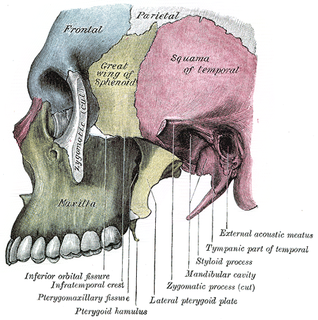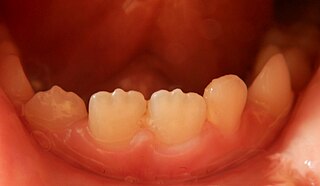Related Research Articles

In mammalian oral anatomy, the canine teeth, also called cuspids, dog teeth, or fangs, eye teeth, vampire teeth, or vampire fangs, are the relatively long, pointed teeth. They can appear more flattened however, causing them to resemble incisors and leading them to be called incisiform. They developed and are used primarily for firmly holding food in order to tear it apart, and occasionally as weapons. They are often the largest teeth in a mammal's mouth. Individuals of most species that develop them normally have four, two in the upper jaw and two in the lower, separated within each jaw by incisors; humans and dogs are examples. In most species, canines are the anterior-most teeth in the maxillary bone.

The maxilla in vertebrates is the upper fixed bone of the jaw formed from the fusion of two maxillary bones. In humans, the upper jaw includes the hard palate in the front of the mouth. The two maxillary bones are fused at the intermaxillary suture, forming the anterior nasal spine. This is similar to the mandible, which is also a fusion of two mandibular bones at the mandibular symphysis. The mandible is the movable part of the jaw.
Raphe has several different meanings in science.

In anatomy, a process is a projection or outgrowth of tissue from a larger body. For instance, in a vertebra, a process may serve for muscle attachment and leverage, or to fit, with another vertebra. The word is used even at the microanatomic level, where cells can have processes such as cilia or pedicels. Depending on the tissue, processes may also be called by other terms, such as apophysis, tubercle, or protuberance.

The thyroid cartilage is the largest of the nine cartilages that make up the laryngeal skeleton, the cartilage structure in and around the trachea that contains the larynx. It does not completely encircle the larynx.

The pyramid-shaped maxillary sinus is the largest of the paranasal sinuses, and drains into the middle meatus of the nose through the osteomeatal complex.
Bruit, also called vascular murmur, is the abnormal sound generated by turbulent flow of blood in an artery due to either an area of partial obstruction or a localized high rate of blood flow through an unobstructed artery.

Continuous with the dorsal end of the first pharyngeal arch, and growing forward from its cephalic border, is a triangular process, the maxillary prominence, the ventral extremity of which is separated from the mandibular arch by a ">"-shaped notch.

Retrognathia is a type of malocclusion which refers to an abnormal posterior positioning of the maxilla or mandible, particularly the mandible, relative to the facial skeleton and soft tissues.
Dorland's is the brand name of a family of medical reference works in various media spanning printed books, CD-ROMs, and online content. The flagship products are Dorland's Illustrated Medical Dictionary and Dorland's Pocket Medical Dictionary. The principal dictionary was first published in 1890 as the American Illustrated Medical Dictionary, including 770 pages. The pocket edition, called the American Pocket Medical Dictionary, was first published in 1898, consisting of just over 500 pages.

Culdocentesis is a medical procedure involving the extraction of fluid from the pouch of Douglas through a needle. It can be one diagnostic technique used in identifying pelvic inflammatory disease and ruptured ectopic pregnancies that cause hemoperitoneum.

The frontonasal process, or frontonasal prominence is one of the five swellings that develop to form the face. The frontonasal process is unpaired, and the others are the paired maxillary prominences, and the paired mandibular prominences. During the fourth week of embryonic development, an area of thickened ectoderm develops, on each side of the frontonasal process called the nasal placodes or olfactory placodes, and appear immediately under the forebrain.

The human nose is the most protruding part of the face. It bears the nostrils and is the first organ of the respiratory system. It is also the principal organ in the olfactory system. The shape of the nose is determined by the nasal bones and the nasal cartilages, including the nasal septum which separates the nostrils and divides the nasal cavity into two. On average the nose of a male is larger than that of a female.

Nasopharyngeal angiofibroma is a histologically benign but locally aggressive vascular tumor of the nasopharynx that arises from the superior margin of the sphenopalatine foramen and grows in the back of the nasal cavity. It most commonly affects adolescent males . Though it is a benign tumor, it is locally invasive and can invade the nose, cheek, orbit, or brain. Patients with nasopharyngeal angiofibroma usually present with one-sided nasal obstruction with profuse epistaxis.
An antithrombotic agent is a drug that reduces the formation of blood clots (thrombi). Antithrombotics can be used therapeutically for prevention or treatment of a dangerous blood clot. In the U.S., the American College of Chest Physicians publishes clinical guidelines for clinicians for the use of these drugs to treat and prevent a variety of diseases.

A mamelon is one of three rounded protuberances which are present on the cutting edge of an incisor tooth when it first erupts through the gum. Mamelons' appearance can be smoothed by a dentist if they have not been worn down naturally by biting and eating foods. Mamelons are present on permanent central and lateral incisors. Mamelons are easiest to observe on the maxillary central incisors, and appear as three small prominences on the incisal edge of the tooth. Mamelons are ordinarily of no clinical importance. Usually they are worn off early in the life of the tooth. However, when an anterior open bite is present—that is, the anterior teeth are not in contact when the bite is fully closed—mamelons may remain into adulthood.
Glomerulopathy is a set of diseases affecting the glomeruli of the nephron.
Macrostomia refers to a mouth that is unusually wide. The term is from the Greek prefix makro- meaning "large" and from Greek στόμα, "mouth".

Overbite medically refers to the extent of vertical (superior-inferior) overlap of the maxillary central incisors over the mandibular central incisors, measured relative to the incisal ridges.

A nucleated red blood cell (NRBC), also known by several other names, is a red blood cell that contains a cell nucleus. Almost all vertebrate organisms have hemoglobin-containing cells in their blood, and with the exception of mammals, all of these red blood cells are nucleated. In mammals, NRBCs occur in normal development as precursors to mature red blood cells in erythropoiesis, the process by which the body produces red blood cells. NRBCs are normally found in the bone marrow of humans of all ages and in the blood of fetuses and newborn infants. After infancy, RBCs normally contain a nucleus only during the very early stages of the cell's life, and the nucleus is ejected as a normal part of cellular differentiation before the cell is released into the bloodstream. Thus, if NRBCs are identified on an adult's complete blood count or peripheral blood smear, it suggests that there is a very high demand for the bone marrow to produce RBCs, and immature RBCs are being released into circulation. Possible pathologic causes include anemia, myelofibrosis, thalassemia, miliary tuberculosis, cancers involving bone marrow, and in chronic hypoxemia.
References
| This human musculoskeletal system article is a stub. You can help Wikipedia by expanding it. |